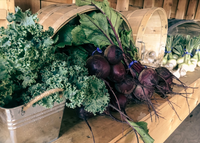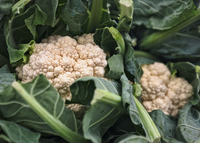There are so many parts of our homegrown vegetables that are going to waste
Our goal as gardeners is to grow our own food, whether that's for self-sufficiency, having control over growing practices, or to live a more sustainable life. But many of us don't know just how much of these vegetable plants are actually edible. You’re likely already growing many of these veggies, so why not get more food out of your garden space without having to plant more? This takes zero-waste gardening to a whole new level.
Here are all the parts of plants that you can eat (that you might not have known you could eat)...
1. Arugula flowers
If you’ve ever tried to grow arugula past spring, you know that it can be extremely unsuccessful if you live in a hotter climate. Arugula prefers cold spring weather and late fall weather (and even being overwintered in certain locations)—and in the summer you’ll find an overwhelming amount of flowers. Don’t chop them down! These flowers will give you your arugula fix as they’re peppery and spicy just like the leaf and go wonderfully in your salad mix.
2. Collard, kale and mustard seed heads Photo by Jason Grant on Unsplash
Photo by Jason Grant on Unsplash
Leafy brassicas like kale, collards and mustards are known to overwinter and then emerge in the spring with plenty of seed pods ready to go. Unless you’re looking to save your seeds for next season, these little pods are like miniature broccoli florets and can be eaten or used the same way (or you can just munch on them right in the garden).
3. Sweet potato leaves
We’ll start this one with a little footnote that some yam* varieties don’t have edible leaves; many people get yams and sweet potatoes confused, but true sweet potatoes do have edible leaves. Another important note here is that sweet potatoes and regular potatoes are not related and potato leaves (just like green potatoes) are toxic to humans. Now, sweet potato leaves are massively abundant through the summer (just you wait and see) and won’t mind being harvested for their sweet greens while you wait for the tuber.
4. Zucchini flowers
These blossoms (pictured above) have such a unique flavour: floral, yet squash-like. Only use the male flowers (and only when you have excess, or else you might end up with no zucchini fruit). These blossoms can be thrown into any stir-fry, or better yet, stuff them with cheese, dip them in batter, and bake or fry them.
5. Cucumber leaves
Really, any member of the cucurbit family has edible leaves, so take your pick. The younger leaves are best because they’re tender, but larger leaves (and stems) are great when cooked with diced tomatoes, a bit of broth to steam them, and some garlic and onions. Be mindful not to over-pick the leaves, mainly for cucumbers, because it can stunt the growth of your plant.
6. Squash shoots
To piggyback on the squash leaves, the shoots are worthy of their own mention here. The cluster of stems and leaves that grows on the last few inches of the squash vine is called a squash shoot, and it is oh-so-tender and scrumptious. Like the larger leaves, these can be cooked and used in replacement of other greens.
7. Sunflowers
We grow these beautiful flowers for their appearance and for their dried seeds, but did you know that you can eat the flower itself? The petals of mature blooms and the greens are edible, and the unopened buds are too (although, you’ll miss out on the sunflower in this case). Cook the greens and buds, but the petals are nutty and delicious raw when thrown into a salad.
8. Beet, carrot, radish and turnip greens
These are such a common compost or soup pot item: root vegetable greens! So few know about the delicious bonus green that comes with your roots, and they’re missing out on a lot of nutrients. Between beet top hummus, carrot top salsa, turnip green pesto and fried radish green, there are infinite ways to maximize this entire crop.
9. Broccoli and cauliflower leaves Photo by Eric Prouzet on Unsplash
Photo by Eric Prouzet on Unsplash
Unlike store-bought broccoli and cauliflower—where the greens are wilted and pale—homegrown plants boast luscious leaves. They taste like a more mild version of collard greens and can be cooked the same way: in soups, stews and braises.
10. Leek tops
An unpopular option—as everyone says to only eat the white part of the leek while the rest is useless. Whether this is for aesthetic reasons or not, leek tops and leek greens are absolutely edible (beyond being part of your soup stock). They can be fried just like onions (they might just take a smidge longer) and as soon as they soften, they add a burst of flavour to any dish.
There are so many other parts of veggies and fruits that can be eaten—it just takes a little preparation and imagination. But putting a little creativity into our meals is absolutely worth it for the sake of more food and less waste.


